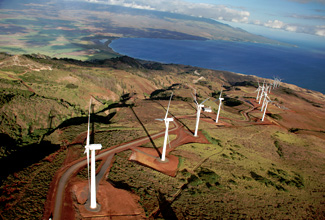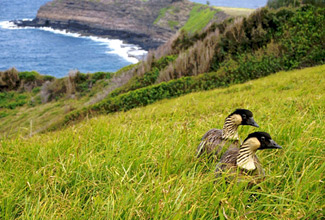Species-rich Hawaii poses unique challenges for wind power industry
by Laura Petersen, E&E reporter
Plans to harness Hawaii's legendary ocean breezes to generate electricity for local utilities have produced a negative blowback from critics who say Hawaii's status as a world-class wildlife sanctuary could be undermined by wind turbines that have been linked to bird and bat mortalities in other parts of the United States.
And while so far wind power development blueprints for Hawaii have been modest compared to some of the massive wind farms of California or Texas, there is little doubt that even small wind farms could have outsized impacts on wildlife in Hawaii, whose rarified climate and geography make it home to the world's most prized bird species.
Yet Hawaii the bird paradise is also the bird extinction capital of the world. Of the 113 unique bird species that once lived only on Hawaii, 73 have gone extinct, and 33 of the islands' 43 remaining bird species are endangered.
At the same time, Hawaii is the nation's most fossil fuel-dependent state, a designation state leaders have worked hard to overcome by encouraging renewable energy development. Hawaii's renewable portfolio standard, for example, requires that utilities produce or purchase 20 percent of their electricity from renewable sources by the end of 2020, and the state has set a non-binding goal of doubling its RPS to 40 percent by 2030.
 First Wind is expanding its 20-turbine Kaheawa wind farm on Maui by another 14 turbines, which are expected to impact several endangered bird and bat species. Building wind power in Hawaii is extra challenging since the islands are home to so many rare and protected species. Photo courtesy of First Wind.
First Wind is expanding its 20-turbine Kaheawa wind farm on Maui by another 14 turbines, which are expected to impact several endangered bird and bat species. Building wind power in Hawaii is extra challenging since the islands are home to so many rare and protected species. Photo courtesy of First Wind.
While much of that new energy is expected to come from non-wind sources -- including solar, biomass and emerging wave energy technologies -- wind power has already gained a foothold in the state and developers are seeking to grow their operations as demand for renewable energy expands.
Boston-based First Wind, for example, developed a 20-turbine wind farm on Maui in 2006 and is now expanding that facility by another 14 turbines. The combined projects, known as Kaheawa Wind I and II, are projected to produce 51 megawatts of electricity for Maui Electric Co. Ltd., a subsidiary of the 1.2 million-customer Hawaiian Electric Co.
First Wind also recently completed a 12-turbine wind farm on Oahu, the state's most populated island, and will soon begin providing 30 megawatts of electricity to Hawaiian Electric's grid.
But both projects came with significant wildlife trade-offs. The Kaheawa project affects four federally protected species: the endangered Hawaiian goose, Hawaiian hoary bat and Hawaiian petrel, and the threatened Newell's shearwater.
The Kahuku project, meanwhile, will affect the shearwater, petrel and hoary bat, as well as three endangered waterfowl -- the Hawaiian stilt, Hawaiian coot and Hawaiian duck -- and the state-listed Hawaiian short-eared owl.
Projects that disturb, harm or kill protected species must receive "incidental take" permits from the Fish and Wildlife Service and be licensed by the Hawaiian Department of Land and Natural Resources. And in the case of First Wind's projects, the company will offset harm to species under special agreements known as habitat conservation plans (HCPs).
Such plans, authorized under Section 10 of the Endangered Species Act, allow for limited species takings in exchange for the responsible party performing other mitigation and restoration work. HCPs have been widely used in other parts of the country, but the First Wind plans in Hawaii are believed to be the first for wind farms. Also in Hawaii, HCPs must do more than simply offset species losses, but result in a net benefit to the affected species.
To date, the Kaheawa Wind I project has killed one Hawaiian petrel, four Hawaiian geese and one bat, all within acceptable take levels, according to state and federal regulators.
As part of its Kaheawa plan, First Wind donated more than $260,000 to expand a Hawaiian goose captive breeding program, and officials agreed to help locate and protect boroughs for petrel and shearwater, two ground-nesting seabirds that are threatened by mongoose, cats and rats that eat the birds and their eggs, and cattle that crush their burrows. Part of First Wind's agreement calls for the company to fence off the petrel and shearwater burrows to keep the offending species out.
Similarly, the HCP for Oahu calls for predator control and marsh vegetation maintenance for three to five years to benefit water birds; up to $150,000 for bat habitat management; and at least $25,000 for owl research and rehabilitation.
 The Hawaiian goose is one of three endangered birds affected by wind power development on Maui. Developer First Wind has donated more than $260,000 to expand an ongoing Hawaiian goose captive breeding program. Photo courtesy of FWS.
The Hawaiian goose is one of three endangered birds affected by wind power development on Maui. Developer First Wind has donated more than $260,000 to expand an ongoing Hawaiian goose captive breeding program. Photo courtesy of FWS.
First Wind is seeking to combine its mitigation efforts for sea birds from both the Kahuku and Kaheawa projects into one site, even though state wildlife managers prefer mitigation occur as close to the disturbed sites as possible.
Slow implementation
Yet five years after completing the first phase of its Kaheawa wind farm, First Wind has yet to fence off the petrel and shearwater burrows on Maui. "The first four years of mitigation work did not go as well as we would have liked," said Scott Fretz, wildlife program manager for Hawaii Department of Land and Natural Resources.
And while biologists were able to find a viable colony of birds on Maui, locating their burrows is a "tall order," said Dave Cowan, First Wind's vice president of environmental affairs.
Hawaii regulators, frustrated by the slow progress, recently agreed to allow specially trained dogs from New Zealand to come to Maui to sniff out bird nests. The state has also questioned whether the company biologists and environmental technicians have adequately monitored for dead birds around the turbines. As a result, the company's bird mortality surveys will now undergo closer government scrutiny, and the state will conduct its own research to make sure the counts are accurate.
In spite of those problems, state regulators last year approved the HCP for the second phase, in part so the project could break ground in time for First Wind to receive federal stimulus funding under the American Recovery and Reinvestment Act.
Before the new turbines can be installed, FWS must complete work on the company's "incidental take permit," and the agency has extended its public comment period on those terms through March 10. Under the proposed terms, the phase II project can take between 10 and 18 adult or immature birds per species and between two and 11 chicks or eggs per species, and 6 adult and 4 juvenile bats, over its 20-year lifespan.
Critics of the proposal, however, including the American Bird Conservancy, have questioned whether First Wind should be allowed to expand its operations on Hawaii given the ongoing problems with the existing HCP.
"If it's been so hard to get the mitigation for this first wind farm done in a timely fashion, how are we going to do it for all the wind farms that need to happen?" said Kelly Fuller, the group's wind campaign coordinator.
Fuller also expressed skepticism over First Wind's reports on the number of killed birds and bats due to the inherent difficulty in finding them. This is especially true for the Kaheawa turbines, which are sited above steep, vegetated ravines. If an injured or dead bird falls into one of those ravines, it is unlikely to be counted, Fuller said.
"It's critical we get this right," Fuller added. "What we don't want to do is solve the burning oil problem, solve the climate change problem by getting all this wind energy built and then find out we've destroyed our endangered bird species."
'Cutting edge' approach
Cowan, the First Wind vice president, described the company's mitigation efforts on Hawaii as "cutting edge," adding that much of the work goes above and beyond the requirements of the HCP and will likely exceed $1 million over the life of the project.
While acknowledging the company would like to have moved more quickly to protect burrows, Cowan stressed the difficulty of finding the nests in such a remote and rugged area where little data exists about where the birds establish burrows.
"You want to do it quickly, but sometimes that is not the most important thing," Cowan said. "The most important thing is it be done well and right."
Dawn Greenlee, the FWS biologist who is overseeing the Kaheawa HCPs, said the agency worked closely with First Wind to develop the HCP for the first phase and remains satisfied with the mitigation measures proposed for the second phase. However, she said, regulators remain concerned about whether the company's planned budget for the work will be sufficient since it has yet to identify burrow sites.
A letter of credit put up by the company at the beginning of the project is the only guarantee FWS has the terms of the HCP will be carried out. But without detailed survey results showing where the bird nests are located, there can be no guarantee that First Wind has pledged enough funds to the project.
Greenlee said approving the phase II project without a firmer guarantee of funding needed to meet the HCP's terms establishes a bad precedent for other development proposals. "I am having a really hard time getting other wind developers to do their surveys in advance because they are pointing at this one and saying, 'Well, you didn't require it of our competitor,'" Greenlee said.
Fretz, the Hawaii Department of Land and Natural Resources wildlife manager, said the state would require each new project to meet species mitigation standards based on the best available information at the time. And, he added, developers who do not meet HCP requirements will be held accountable by the state's Endangered Species Recovery Committee.
"If the committee has not seen progress being made and there is a net loss, they are going to revoke the license," Fretz said.
Other environmental groups seem more willing to allow the wind industry to work through some of the difficulties of working in a species-rich environment like Hawaii.
The Sierra Club's Maui chapter, for example, has applauded Find Wind's efforts to date.
"They are doing a good job," said Lance Holter, chairman of the Sierra Club Maui Group. "I think they are genuine in wanting to be a good neighbor. When I look up there and see the wind mills, it makes me feel like we're trying to enter the 21st century in renewables."
---30---
RELATED: